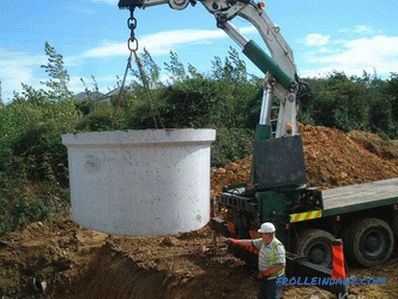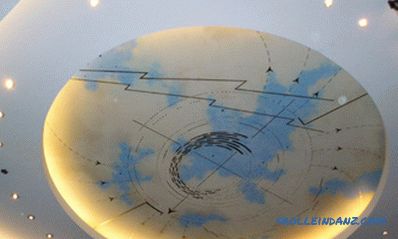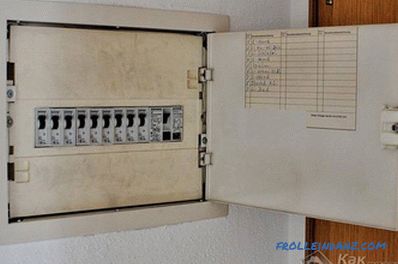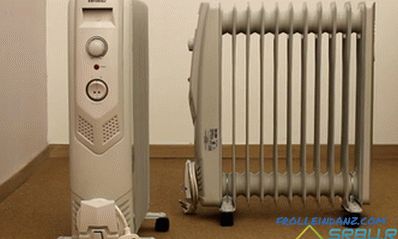This article is about how to paint the walls in an apartment. Perhaps you want to refresh the look of your home, or you want to drastically change the interior to better suit your tastes ... Take a roller, brushes and go ahead. This procedure is quite simple, but we still will tell you in our step-by-step instructions on how to do it correctly. If you follow our advice, the result of your work will be no worse than that of a professional.

Recommendations for painting walls
1. You must carefully measure the surface area you want to paint to know exactly the amount of paint you need. Having decided on the color, go to the local building materials store. Carefully read the label on the paint can in order to know exactly the surface area and drying time.
2. Prepare the surface before painting. It is necessary to remove the previous layers of paint with a scraper and sandpaper, degrease the surface and, if necessary, repair chipped and chipped areas with a putty. Apply several coats of acrylic primer to improve adhesion of paint to the wall material. Do not skip this step, otherwise the paint will not lie flat and securely communicate with the substrate.
3. After you have painted the walls, you need to replace the sockets and switches that you removed before starting work. Then clean the floor and remove the covers that protect the furniture from dust. Move the furniture into place, being careful not to scratch the floor.
Materials:
- paint;
- primer;
- abrasive paper 120 grit;
- masking tape;
- plastic wrap.
Tools:
- protective gloves and goggles;
- brush;
- 5 cm wide roller (for corners);
- large roller;
- paint tray;
- vacuum cleaner, bucket.
Tips:
- Wear old clothes that you don’t wear and you’ll no longer wear because you for sure, peremazhaetsya paint;
- before painting, eliminate all the irregularities of the walls;
- apply a layer of primer, especially if you are painting the walls in the new building;
- apply a second layer of paint after full drying out first.
Preparing the room for painting walls
In the figure below you can see the tools you need to paint the walls. You need rollers of different sizes and relief (to create different textures), an emery block for manual polishing and paper masking tape designed to protect various elements from paint contamination. In addition, you can not do without a tray for paint.
Remove the curtains. Move the furniture in the middle of the room and close it with plastic wrap or special covers.
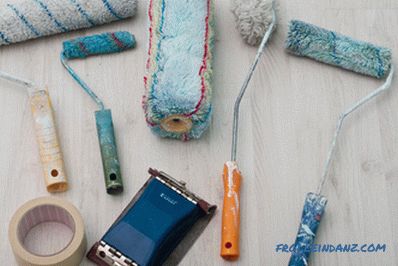
Painting tools.
The next step is to protect the plinth paint and other interior elements from possible smudges and drops of paint. To do this, you will need masking tape - a cheap, but very useful material.
Tip: Cover the windows, doors and floor with plastic wrap, which can be fastened with the same masking tape. Otherwise, you will have to remove paint droplets from all these surfaces, which is sometimes not so easy to do.
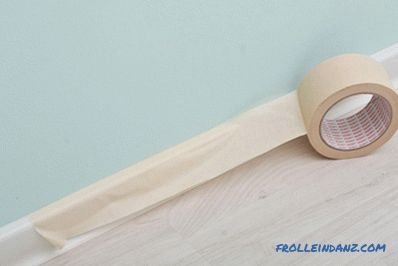
Protection of the plinth with masking tape.
Preparing walls for painting is an excellent opportunity to level their surfaces and eliminate various defects. In addition, you have to fill the potholes and cracks with plaster or putty with a small flat trowel. When the material is dry, level the surface with 120 grit sandpaper. Remove dust and dirt from the walls with a sponge or clean cloth using a suitable detergent. At the end, vacuum the floor.
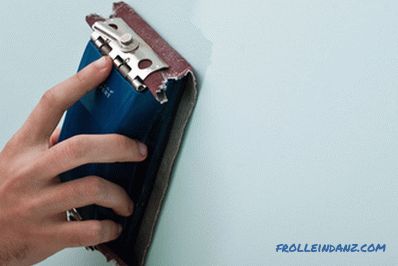
Sanding walls before painting
Next, you must turn off the power supply and remove the covers of sockets and switches in order to paint the walls close to high quality and not paint the electrical equipment.
Tip: Cover the inside of the sockets and switches with molar tape to protect them from dirt and paint. Work patiently, as the preparatory stage is nearing its end.
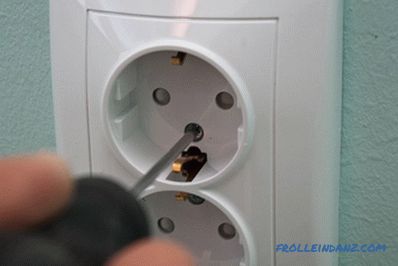
Removing the outlet covers.
It is also necessary to temporarily remove the radiators in order to be able to paint the wall surface behind them. To do this, you must first close the valves. Then place the sump at the pipe inlet to prevent water from entering the floor. Unscrew the captive nuts connecting the radiator to the pipes and drain the water. When the water stops flowing, remove the radiator from the brackets holding it and pour out the remaining liquid.
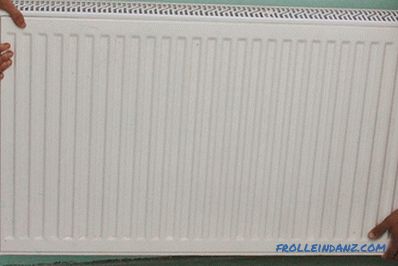
Removing radiators.
Getting to paint the walls
If you want to paint only part of the wall, make a border using masking tape.Adherents of traditional design should stick paper tape along the ceiling.
Tip: Make sure that the tape is glued at the same level. To do this you need a laser or alcohol level.
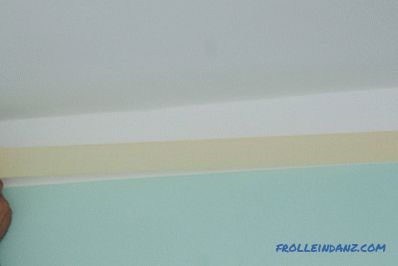
Masking tape sticker before painting
You can choose the height at which you want to place the masking tape. It does not even have to be a horizontal line - the choice of location and shape depends on your tastes and needs.
Tip: For a quality adhesive tape, lightly press it with your hands. You must be sure that there are no unglued areas left and, therefore, paint will not leak under the tape, otherwise the dividing line will not turn out to be perfectly flat.
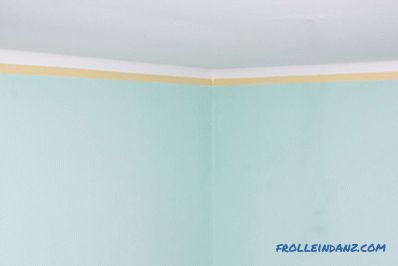
Using masking tape to create different areas when painting.
Start painting the walls with areas around the door jamb. To do this, you will need a small roller specifically designed for narrow surfaces.
Tip: In order not to paint the wood, in the immediate vicinity of the shoals, use a small brush (2-5 cm wide). Try not to touch the shoals, or pre-paste them with masking tape.
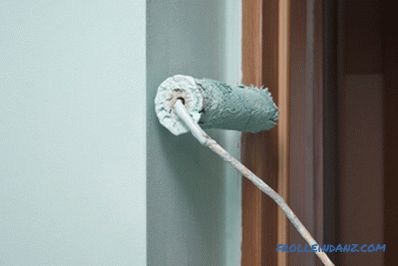
Paint roller walls around the door jamb.
Now it's the turn of the corners of the room, the areas around the windows, along the ceiling and baseboards, around the switches and sockets. To paint the walls in these places it is more convenient to use a small brush, as it allows you to better control the situation. Aim for straight lines.
Do not apply too much paint at one time and roll out all the drops and smudges before proceeding to the next section. Try to apply the paint as evenly as possible.
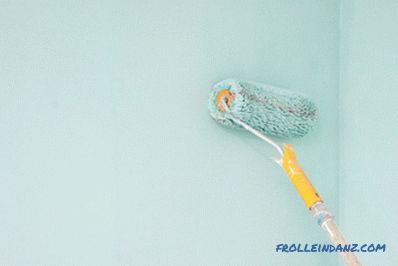
Painting the corners of the room.
After you have finished painting in the corners, along the ceiling and baseboards, you can begin to apply a layer of paint on the remaining surfaces. Using a large roller, apply paint on the wall with vertical movements. Aim to ensure that the coating was uniform. No need to approach the ceiling and baseboards, since you have already painted these areas.
As a rule, a single coat of paint is not enough, so you will have to apply at least two coats to get a coating of proper quality. Before applying a new layer, wait until the previous one is completely dry.
Tip: If the smears become non-uniform, it is time to upgrade the roller. Carefully ensure that dust and other small particles do not enter the room - they can damage the finish.
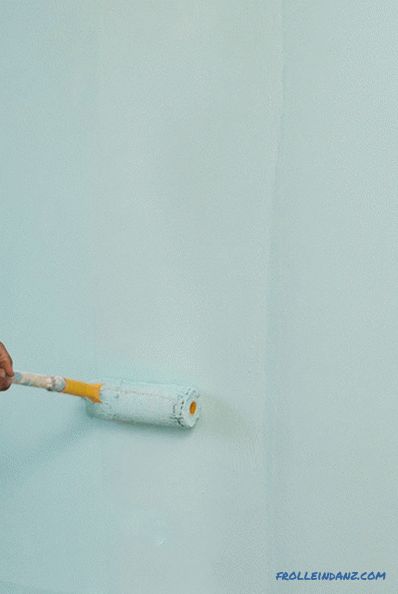
Painting the walls with a roller.
To speed up the work, we recommend that you use a large roller and paint tray. Do not overfill the tray with paint (it should be filled to about a third of the volume), otherwise it will be difficult to dip the roller in it. Roll the roller several times back and forth across the paint, and then across the top of the tray so that the paint spreads across the roller evenly.
Apply paint to the wall with vertical roller strokes. The paint dries quickly enough, so try not to delay the process too much, otherwise the neighboring areas will have time to dry, and as a result the layer will not be applied sufficiently evenly.
Tip: When you only apply paint to a site, move the roller in one direction (up or down) to get an even layer over the entire surface, with no visible marks.
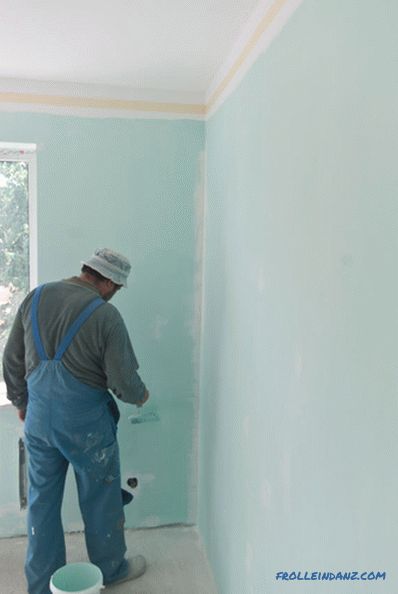
How to paint a wall with a roller.
After you have finished painting the walls in the room, you should once again make sure that there are no areas of uneven application of a layer of paint, drops, smudges and other blemishes. If necessary, correct the defect with a roller.
If you think that the walls have been painted perfectly, you can proceed to the last step - removing the paper tape. This should be done before the paint dries. Try to remove the tape gently, so as not to damage the edges of the freshly applied coating.
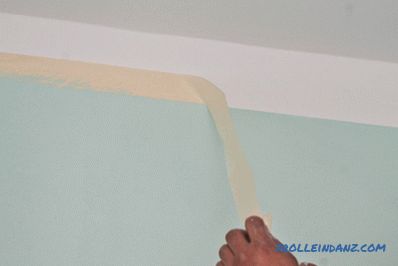
Removing the masking tape.
As a rule, it takes about a day to completely dry the paint (time depends on the room temperature and the type of paint used). During this period, it is advisable to thoroughly ventilate the room, while avoiding contact with street dust. Any small particles (dust, dirt, etc.) can damage the finish, so pay attention to this aspect.
Now you know how to properly paint walls with water-based paint. This type of paint today is most often used for interior decoration and we used it in our project. However, if you suddenly want to paint the walls with oil or any other paint, the knowledge gained here will be useful, since the basic principles of working with paint do not depend much on its composition.
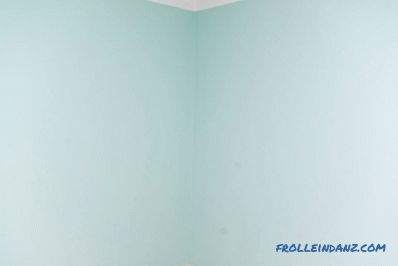
A hand-painted room.
Source of translation: www. howtospecialist.com
